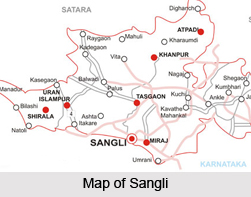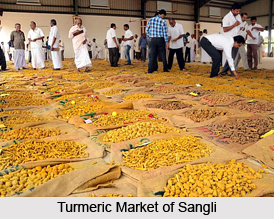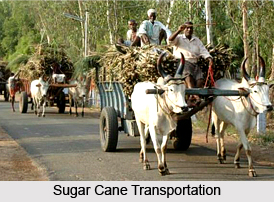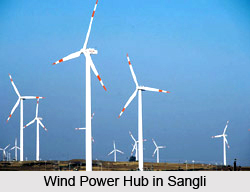 Sangli city is located in Western India on the banks of river Krishna. Sangli is the administrative head quarter of the Sangli district. Except the turmeric center of Asia, this green city is also called `Sugar Belt` of Maharashtra. Miraj the twin city of Sangli is a major railway junction and a major Healthcare centre with reputed hospitals like Cancer Hospital, Wan less Hospital, Mental Hospital, etc. The city derives its name from "Saha Galli" ("Six Lanes" in Marathi).
Sangli city is located in Western India on the banks of river Krishna. Sangli is the administrative head quarter of the Sangli district. Except the turmeric center of Asia, this green city is also called `Sugar Belt` of Maharashtra. Miraj the twin city of Sangli is a major railway junction and a major Healthcare centre with reputed hospitals like Cancer Hospital, Wan less Hospital, Mental Hospital, etc. The city derives its name from "Saha Galli" ("Six Lanes" in Marathi).
History
Sangli, was one of the 11-gun salute princely states of British India,under the Kolhapur-Dekkan Residency in the Bombay Presidency, and later the Deccan States Agency. It was one of the southern Mahratta Jagirs. Its territory was widely scattered among other native states and British districts.
Sangli was part of Maratha Empire, however, there are no direct references mentioning Sangli before 1801. During the time of Shivaji, Sangli, Miraj and surrounding areas were captured from the Mughal Empire. Until 1801, Sangli was included in Miraj Jahagir. The First Chintamanrao Appasaheb Patwardhan established a different principality with Sangli as the capital city.
Sangli joined the Dominion of India on March 8, 1948 and is currently a part of the state of Maharashtra.
Geography
Sangli city is located at 16.4° to 17.1° N lattitude and 73.42° to 75.4° E longitude It acqires the total area of 8601.5 sq.kms. Sangli city`s maximum temperature is 39°C and minimum is 12°C. Krishna river the main river flowing in the city.
Economy
There are various trades and industries are located in this city. They are:
World-famous Turmeric of Sangli
The country`s sole turmeric exchange in Sangli city boasts secrets gained through a centuries-old practice - storing turmeric in pits. These pits stretch far out in the open fields of the villages of Haripur and Sangalwadi. It is possibly the most unusual agricultural commodity-storage system in the country.After clearing the loose soil covering the pit, it is left open for about two to three hours. One cannot enter the pit until one finds out if there is any oxygen within. To ascertain this, a lantern is lowered into the pit. If the lantern does not go out, it is safe to enter the pit.It was this ingenious storage system, devised over 200 years ago, that turned Sangli into a major trading centre for turmeric.
Raw turmeric sold by farmers is stored in these pits, eighteen to twenty feet (five to six metres) deep, for three to four years. The pits provide the best storage facility for turmeric, as the quality of the commodity remains unchanged. The turmeric hardens and matures while in storage.Today, more than 90% of the turmeric trade in India takes place in Sangli.
Sangli: Sugar Belt
The Sangli region is known as the "Sugar Belt of India". This region houses over thirty large sugar factories. Vasantdada Patil, who served as chief minister of Maharashtra for four terms, started the co-operative movement which helped Maharashtra become the most developed state in India. Most of the sugar factories of the Sangli sugar belt work on the co-operative basis.Vasantdada Sugar Factory near Sangli city was the time largest sugar plant in Asia till late 90s.
Krishna Valley Wine Park
The Sangli district has recently entered into wine industry, and has achieved some success in producing classic vintage categories.
Wine producers in Sangli make distinctive, classic wines using imported root stocks. The fertile soil of the Sahyadri hills region, and the long sunny days and dry climate make for an excellent product. The government of Maharashtra has set up a specialized state-of-the-art wine park at Palus, 30 km from Sangli city. This 142-acre (575,000 m²) park, is located close to Tasgaon, which produces one of the best-quality grapes in the world.
Krishna Valley Wine Park has an International Quality Wine Institute which has been set up in association with the Bharati Vidyapeeth, a leading university of India. The institute carries out research in wine manufacturing.
Krishna Valley Wine Park of Sangli has been recognized as an Agri-Export Processing Zone by the Indian government.
Sangli Food Park
The park is being planned on a 305-acre (1.2 square kilometre) plot at Mane-Rajuri near Sangli city. Cebeco (India) is the consultant for the project.The location is best suited for processing grapes, turmeric, mangoes, pomegranates, citrus fruits and custard apple.Common facilities planned are cold-storage, effluent treatment and social infrastructure.
Sangli IT Park
 The city now has an Infotech Park with state-of-the-art facilities waiting for Infotech companies to start operations. Sangli Infotech Park has state-of-the-art modern facilities for software companies. The park is located in an attractive locality surrounded by greenery.
The city now has an Infotech Park with state-of-the-art facilities waiting for Infotech companies to start operations. Sangli Infotech Park has state-of-the-art modern facilities for software companies. The park is located in an attractive locality surrounded by greenery.
Sangli.....Emerging Wind Power Hub in Asia
Suzlon, the largest wind power generation company in India has set up a number of electric power generation wind farms in Sangli. Now, Reliance India`s largest private sector company is setting up 150 MW wind power project worth 90 Billion Indian rupees in Sangli in partnership with Suzlon. This wind power project will generate 380 million units of electricity per annum and generate employment for thousands of skilled / unskilled youth in Sangli.
With this mega power plant, Sangli finds a place on the global map as a major Power Generation Hub.
The other MDIC industries of Sangli are-
•Sangli-Miraj Industrial Area
•Vasantdada Industrial Estate
•Marathe Industrial Estate
•Islampur Industrial Area
•Palus (Tasgaon)Industrial Area
•Kadegaon Industrial Area
•Vita Industrial Area
•Kavathemahankal Industrial Area
•Shiralaor Battis
•Shirala Industrial Area
•Jath Industrial Area
Government
The Sangli-Miraj-Kupwad City Municipal Corporation is the local self-government body which looks after the development of the Sangli-Miraj twin cities. This is the largest municipal corporation in South Maharashtra and serves a population of 0.65 million. Mayor is the head of the Saangli-Miraj-Kupwad City Municipal Corporation.
Transport
By Air: The nearest international airport to Sangli is Mumbai. bangalore is also another international airport nearer to Sangli.
By Rail: By Rail Sangli is linked with all of its neighbouring cities. The twin city Miraj is a major railway junction.
By Road: National Highway-4 is linked with the city Sangli. The road way is well linked Sangli with various neighbouring cities.
Demographics
As per 2001 Census of India, Sangli city had a population of 0.65 million.
Culture
The main language of the city is Marathi, followed by Hindi, English, Kannada and Gujarati. For the entertainment in city there are fifteen multiplexes, four clubs and sports complexes, several swimming pools, cyber cafes are present.
Among various festivals Ganesh pooja is the main festival of Sangli people.
The Valley of river Krishna and its tributaries is one of the greenest areas in the country. There are a number of unknown spots of scenic beauty in and around Krishna Valley near Sangli. The Grand Temple of Lord Ganesh in Sangli is the attraction of Tourists all over India. There are a number of Hindu Shrines and Jain Temples in and around Sangli, which attracts lots of devotees.
Visiting Places
Gokak Water Falls: The Gokak waterfall is just 2 hours travel from Sangli by train. The best time to visit this falls is between June to October as there is plenty of water. There is a swinging bridge on the waterfalls. Gokak Dam and the Hydro-electric Power plant are also worth visiting places there.
Sagareshwar Wild Life Sanctuary: It is just 30 km. from Sangli.
This wild life sanctuary has animals like Deer, jackals, rabbits, peacocks, wild goats, wild cows, leopards, etc. There are many ancient temples of Lord Shiva on the Sagareshwar Hill.
 The region around Sagareshwar also known as Kundal was once the capital of the mighty Chalukya dynasty who ruled India 1600 years ago. Many inscriptions and antiquities are found here.
The region around Sagareshwar also known as Kundal was once the capital of the mighty Chalukya dynasty who ruled India 1600 years ago. Many inscriptions and antiquities are found here.
Kundal is surrounded by hills. One of them, called `Zari Parshwanath` has two caves, which house the idol of Mahavir and the images of Ram, Sita and Lakshmana. A huge trough near these caves provides water even in summer. Villagers used this water during the severe drought of 1972.
The water from this through cascades near the idol of Mahavir, hence this place is called `Zarai Prashwanath`. A large ground on top of another hill is considered holy by the Jains because they believe Mahavir gave sermons to his followers here. This place is called `Samav Sharan`.
Nearby, there are a group of 13 caves, which were used for meditation. A few years ago, an idol of Mahavir was found. Even today, many antiquities are discovered. The Mahavir idol in Jain Basti here is unique, as it is made of sand. Every year, thousands of Jains visit this place.
A temple built in the memory of Maharaja Jaising stands even today. Jaising`s grandson Pulkeshin shifted his capital to Watatipur (present day Badami) resulting in the decline of Kundal.
Dandoba Hill Station: This Hill Station is just 25 minutes drive from Sangli-Miraj cities. It is located on Miraj-Pandharpur Road. It is located around Dandoba Hills which is a reserve forest area. Lot of undiscovered floura & fauna can be found in Dandoba. This is a natural place away from the hectic life of the city. Dandoba Hill station is an ideal spot for people trying to explore nature in its true sense. There are also some historical ancient temples on the hills.
Tourists interested in trekking can climb up the hills in groups. Tourists interested in water sports also have lot of options here. Particularly, the region around Bhose Irrigation Lake is of special interest for water sports. Dreamland Water Park situated close to Bhose Irrigation Lake provides lot of amusement to tourists visiting Dandoba Hill Station. The water park has swimming pool, water games, wave pool, cultural park, dashing car, disco parks & other amusements.
Every year a mini marathon race is held from Sangli city upto Dandoba Hill Station.
Chandoli Forests: The Chandoli region, which is about 65 km from Sangli, is surrounded by mountains and thick forests. One can find animals like monkeys, deer, wild goat, rabbits, tigers, peacocks, snakes, etc. in this region. Chandoli dam is also a visiting place. In the rainy season lush green with some small water falls can easily be found in this place . Rare species of trees and plants can be seen here.
Audumbar: It is a holy place about 25 km. from Sangli city. A sacred temple of Lord Dattatraya is located on the banks of Holy Krishna river. Thousands of devotees from all over the world visit Audumbar every year.
Lord Dattatraya Idol at Audumbar is considered very auspicious & has 3 faces. It is said that Lord Dattatraya of Audumbar protects his devotees from all the miseries. During the last century, Maharaja of Sangli state built a temple over the padukas (feet) of Lord Dattatraya and the Ghats on river Krishna.
Birth anniversaries of Shri Dattatreya, Shri Shripad Shrivallabha, Shri Narsimha Sarasvati & Guru-Pratipada, are some of the festivals celebrated here. A ceremonial procession known as Palkhi is taken out on every Saturday & Full Moon day.
Bahuballi Hill Temples (Kumbhojgiri): Bahuballi is 50 minutes drive from Sangli.
Bahuballi Hill temples are a place of worship for Jain Devotees all over the world. There is a tall statue of Lord Bahuballi on the foothills of Bahuballi Hills popularly known as Kumbhojgiri. There are some other Jain idols around the Bahuballi statue. To see the Hill temples you have to climb about 400 steps. The Temple of Lord Shri Jagvallabh Parshwanath on the hills is believed to be highly worshipped by the Jains. There are also some other Jain Temples on the Hill.
The Swetambar Jain Trust here provides free boarding & lunch for all Jain devotees.
Battis Shirala : It is a small village about 65 km from Sangli in hilly area covered by thick forests. These forests have a wide species of snakes right from the deadliest King Cobra to the rare species of pythons. Every year during Naga Panchami, the Snake Festival, youths from nearby region catch these poisonous snakes & arrange snake shows for visitors & foreign tourists. Thousands of visitors from India & abroad visit this Snake Festival. After a period of 8-10 days these snakes are freed into the forests.
Education
Sangli is also a major education centre. There are number of engineering, management and law, medical and pharmacy colleges in and around Sangli. Hundreds of computer software training institutes has also come up in the region. The medium of education in schools is English as well as Marathi.
All major institutions are:
Engineering Colleges of Sangli:
•Walchand College of engineering
•Padma Bhushan Vasantdada Patil Institute of Technology (P.V.P.I.T.)
•Sant Dnyaneshwar College of Engineering and Technology
•Rajarambapu Institute of Technology
•Lathe Education Society Polytechnic
•Government Polytechnic, Miraj
•J. J. Magdum College of Engineering.
Major Management Institutions are:
•Bharati Vidyapeeth Institute of Management,Rajwada Chowk
•Sangli Deccan Education Society`s Institute of Management, Vishrambag
•Sangli Lathe Education Society`s Institute of Management, Sangli
•Vasantdada Institute of Management, Wanlesswadi, Sangli
•Rajarambapu Institute of Management, Sakharale, Sangli
•Balwant College, Vita, Sangli
Major medical institutions of the city:
•Government Medical College, Miraj, Sangli
•Bharati Vidyapeeth Medical College, Wanlesswadi, Sangli
•Bharati Vidyapeeth Dental College, Wanlesswadi, Sangli
•Vasantdada Patil Ayurvedic Medical College, Vishrambag, Sangli
•Vasantdada Patil Dental College, Kawalapur, Sangli
•Annasaheb Dange Ayurvedic Medical College, Ashta, Sangli
•Rajarambapu Patil Ayurvedic Medical College, Islampur, Sangli
•Gulabrao Patil Homeopathic Medical College, Sangli
The Pharmacy institutions of the city are:
•Birnale College of Pharmacy, Sangli
•Miraj Govt. College of Pharmacy, Miraj
•Gulabrao Patil College of Pharmacy, Sangli
•Rajarambapu College of Pharmacy, Kasegaon, Sangli
 The Law colleges of the city are:
The Law colleges of the city are:
•Lathe Education Society`s Law College, Sangli
•Bharati Vidyapeeth Law College, Sangli
The other various colleges are:
•Willingdon College of Arts and Science
•Bharati Vidyapeeth College of Arts, Commerce and Science
•Kasturbai Walchand college of Arts, Science and Commerce
•Garware College of Arts and Commerce
•Chintamanrao College of Commerce
•SNDT Women`s College
•G.A. College of Arts and Commerce
•Shantiniketan College of Arts, Commerce and Science
•Miraj College of Arts, Commerce and Science
•Purohit Girl`s College of of Arts, Commerce and Science
•Rani Saraswati Kanya Shala



















